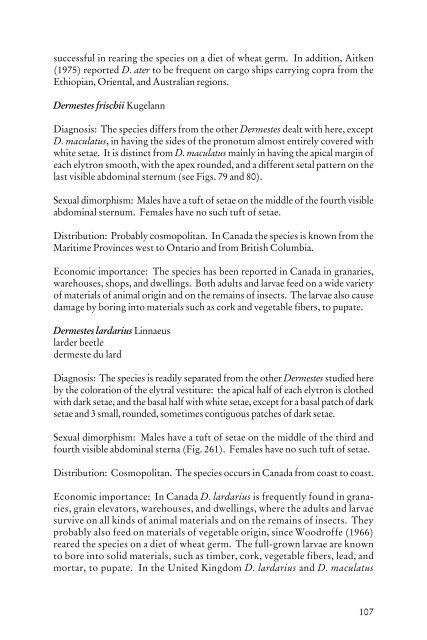Beetles Identification Guide
Beetles Identification Guide
Beetles Identification Guide
You also want an ePaper? Increase the reach of your titles
YUMPU automatically turns print PDFs into web optimized ePapers that Google loves.
successful in rearing the species on a diet of wheat germ. In addition, Aitken<br />
(1975) reported D. ater to be frequent on cargo ships carrying copra from the<br />
Ethiopian, Oriental, and Australian regions.<br />
Dermestes frischii Kugelann<br />
Diagnosis: The species differs from the other Dermestes dealt with here, except<br />
D. maculatus, in having the sides of the pronotum almost entirely covered with<br />
white setae. It is distinct from D. maculatus mainly in having the apical margin of<br />
each elytron smooth, with the apex rounded, and a different setal pattern on the<br />
last visible abdominal sternum (see Figs. 79 and 80).<br />
Sexual dimorphism: Males have a tuft of setae on the middle of the fourth visible<br />
abdominal sternum. Females have no such tuft of setae.<br />
Distribution: Probably cosmopolitan. In Canada the species is known from the<br />
Maritime Provinces west to Ontario and from British Columbia.<br />
Economic importance: The species has been reported in Canada in granaries,<br />
warehouses, shops, and dwellings. Both adults and larvae feed on a wide variety<br />
of materials of animal origin and on the remains of insects. The larvae also cause<br />
damage by boring into materials such as cork and vegetable fibers, to pupate.<br />
Dermestes lardarius Linnaeus<br />
larder beetle<br />
dermeste du lard<br />
Diagnosis: The species is readily separated from the other Dermestes studied here<br />
by the coloration of the elytral vestiture: the apical half of each elytron is clothed<br />
with dark setae, and the basal half with white setae, except for a basal patch of dark<br />
setae and 3 small, rounded, sometimes contiguous patches of dark setae.<br />
Sexual dimorphism: Males have a tuft of setae on the middle of the third and<br />
fourth visible abdominal sterna (Fig. 261). Females have no such tuft of setae.<br />
Distribution: Cosmopolitan. The species occurs in Canada from coast to coast.<br />
Economic importance: In Canada D. lardarius is frequently found in granaries,<br />
grain elevators, warehouses, and dwellings, where the adults and larvae<br />
survive on all kinds of animal materials and on the remains of insects. They<br />
probably also feed on materials of vegetable origin, since Woodroffe (1966)<br />
reared the species on a diet of wheat germ. The full-grown larvae are known<br />
to bore into solid materials, such as timber, cork, vegetable fibers, lead, and<br />
mortar, to pupate. In the United Kingdom D. lardarius and D. maculatus<br />
107
















